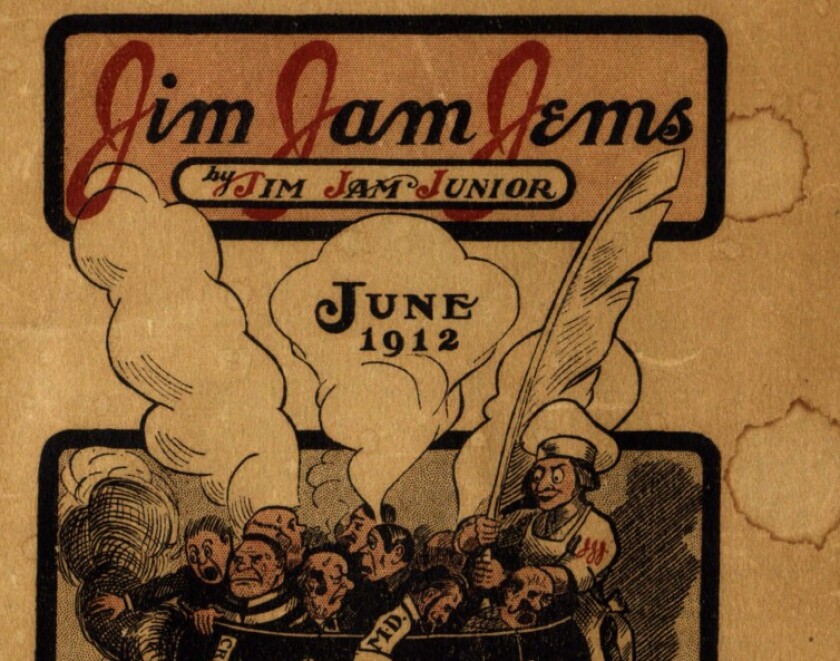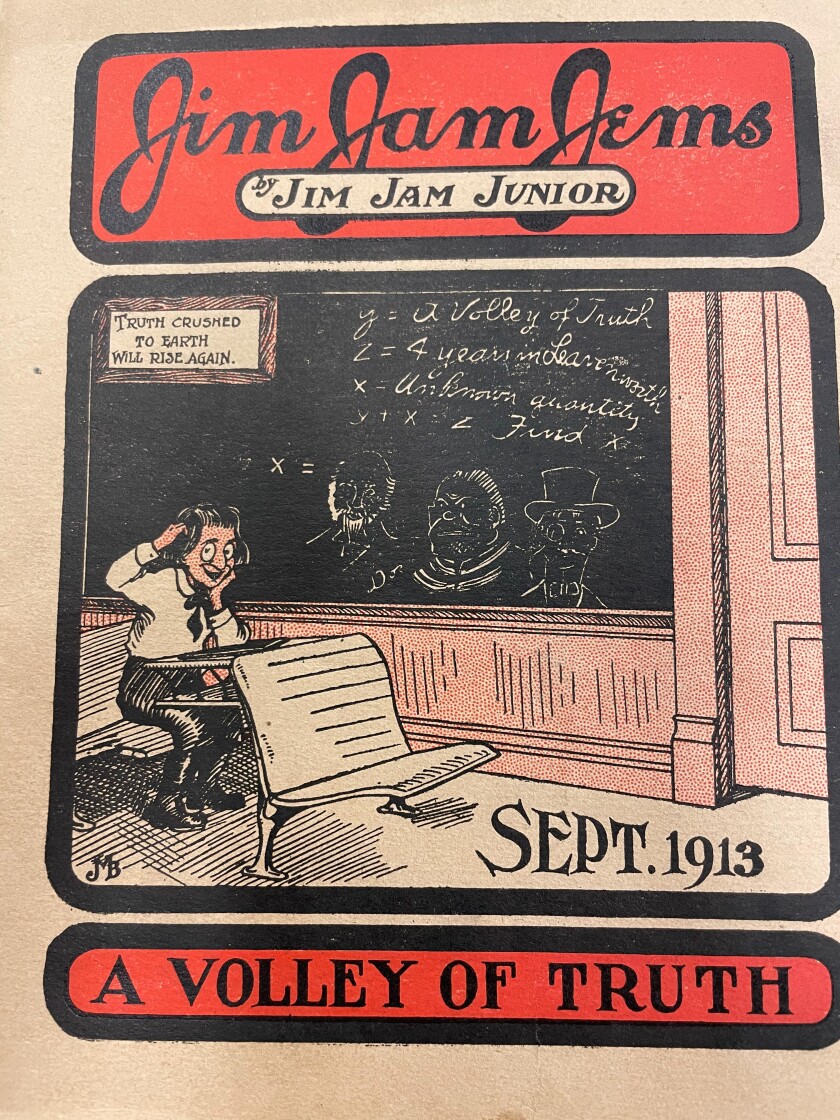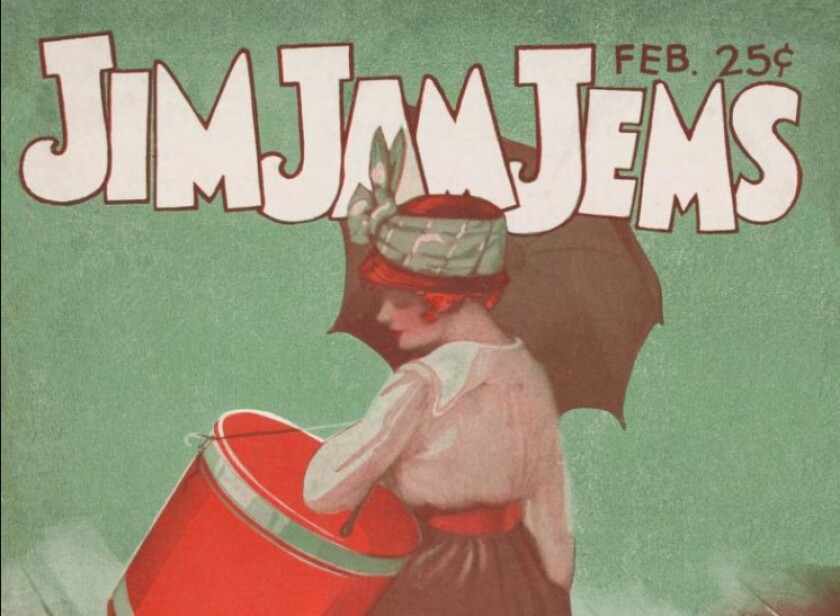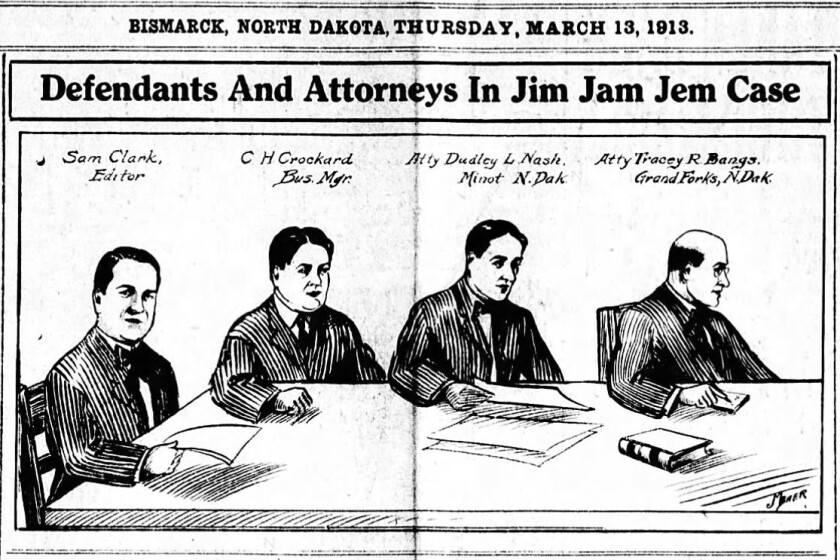BISMARCK, ND — Jim Jam Junior wasn’t just a journalist, a judicial official or a desk jockey in the early 1900s, he was a “favorite with the ladies” — a fast-spending, hard-drinking crusader against what he believed was government corruption.
Jim Jam Junior was a pseudonym. His real name was Sam H. Clark, a newspaperman, an aspiring attorney, a mayor of Minot, North Dakota and “one of the greatest literary figures ever known in North Dakota,” according to a 1962 biography found within North Dakota State University Archives.
ADVERTISEMENT
Clark’s claim to national fame came with the publication of Jim Jam Jems — a booklet-styled monthly magazine no bigger than a grown man’s hand — costing 25 cents each, the equivalent of $8 today.
Described as a unique magazine published in Bismarck, Clark’s style was incendiary and sensational. His stories — including news and in-depth investigations and prose — were sprinkled with humor, satire and political commentary. The 60-page publication began on January 3, 1912, with the question: who is Jim Jam Junior of the “neatly printed booklet … that at once became a sensation?”
During the 17 years it survived, it boasted a wide readership with its slogan, “A volley of truth,” and whenever it came out, according to the Valley City Times-Record.
Clark took up issues ranging from prostitution in Fargo in 1912, the war with Mexico in 1916 and abortion. He also defended Germany before World War I, with one of become a American politicians to Germany’s side, according to Forum News Service and Sage Magazine.
“Every clean mortal in the country — man or woman — welcomed Jim Jam Jems, while … the scalawag and scoundrel, the millionaire seducer of innocence and debaucher of virtue, the criminal abortionist, the thug, the blackmailer and every mortal son of Adam’s misery whose life is a lie — became our sworn enemy,” according Clark in the August 1913 edition.
“Dealing with all types of controversial subjects, it was a muckracking, crusading magazine of the most vigorous type. It pulled no punches,” wrote Dick Tschider in a biography of Clark found within NDSU Archives. “On more than one occasion it was barred from the mails.”

ADVERTISEMENT
‘Minneapolis abortion mill’
Soon after the publication began, Jim Jam Jems published the results of an investigation naming famous doctors in Minneapolis as being criminal abortionists. Abortions were not legal in America until 1973 with the Supreme Court's decision in Roe v. Wade.
In 2022, the Supreme Court overturned Roe v. Wade, allowing states to regulate abortion, as long as the regulations don't violate federal law.
“When Jim Jam Jems trained its publicity guns on Doctor Charles H. Hunter and Doctor Phillip Mueller, two well known physicians in the city of Minneapolis, and charged that they were guilty of the crime of performing criminal operations, the public was severely shocked,” Clark wrote in June 1912.
The story revealed what Clark called a "Minneapolis abortion mill” of doctors and in the ensuing weeks, medical boards in the state expelled the doctors and sought criminal charges against them.
Clark referred to Mueller as “the dollar-a-shot abortionist,” because he charged a low fee for his services, and a patient of his, Emma Magnuson, died after he performed an abortion procedure. Mueller was arrested on May 17, 1912, and put under $7,500 bond, and charged with manslaughter in the first degree, on May 20, 1912.

A federal fight
The “abortion mill” story boosted Jim Jam Jems into the national spotlight, but in November 1912, dealers of Jim Jam Jems were rounded up and arrested in St. Paul, and Clark and Crockard faced charges of violating federal postal laws — in essence, the government alleged they were sending immoral reading material through the mail.
ADVERTISEMENT
Although the publication had many supporters, the Oakes Times criticized Jim Jam Jems by saying: “When such literature gets into the hands of children, young girls and boys, and is passed around and read secretly, then it is time to call for a halt.”
The Bismarck Tribune on March 13, 1913, appeared more supportive: “What may be considered obscene by one person may be considered perfectly clean and legitimate by another.”
Jim Jam Jems won the first case brought against them in Burleigh County District Court, but Clark, and his co-publisher, Clarence H. Crockard, were called before a federal grand jury on June 27, 1913.
They were found guilty of the second of 25 counts of the indictment, and not guilty on all other counts. A jury recommended that no jail sentence be imposed, but the judge sentenced each to serve two years in Leavenworth Federal Penitentiary, to pay a fine of $2,000, and to pay half the costs of prosecution, according to information within NDSU Archives.
Clark and Crockard appealed the verdict, and spent much of their profits to clear their names. Throughout the whole affair the publication continued regularly.
The case brought attention from around the nation, according to the Bismarck Tribune.
“The Jim Jam Jems case is probably the most important federal case ever tried in the state. The magazine is known throughout the United States, having the largest circulation of any one-man magazine in the country. The attempt of the government to suppress the publication has awakened a wide interest, and the fact that a special term of the federal court has been called to again try the case, indicates its importance.”
ADVERTISEMENT
Jim Jam Jems accomplished “much good through its exposures,” and supporters outnumbered those that wanted the magazine suppressed, the Bismarck Tribune reported.
Clark believed that because of his investigations into government corruption and ills of society in the 1910s, that he and his publication were being targeted. The little magazine, Clark said in a December 1913 edition, did not “kowtow to any creed, party, organization, clique, gang set, policy, individual or band of individuals.”
“There is humbuggery, fraud, deception everywhere; we just grew tired of strolling in the realm of make-believe, and decided to look life squarely in the face and tell the truth,” the December 1913 issue reported.
The Jim Jam Jems down.
“That he was an elusive character is evidenced by the fact that four times he was tried by a United States District Court and only once did he come away with the short end of the judgment,” wrote John T. Lynch in a term report on Clark found within NDSU Archives.

The ‘spice writer’
Sam Clark was born to Catholic parents on January 18, 1880, at Little Falls, Minnesota, according to a biography written by Kermie E. Lidstrom found within NDSU Archives. His father, Andrew J. Clark, was a pioneer editor-lawyer in Marshall County, Minnesota. He was also a county attorney and the creator of the original Jim Jam Jems.
ADVERTISEMENT
At a young age, Sam and his brother, Charlie, served as apprentices in their father’s print shop at Little Falls and later in Stephen, Minnesota.
Clark was a handsome type, and a favorite with the ladies, as well as an avid fisherman and hunter.
In 1896 Sam and Charlie moved to Kennedy, Minnesota and the Kennedy Screwdriver. With an old press and screw type, they were ready for business. In 1900 they sold out to E.M. Engelbert, the downstairs druggist, who changed it to the “Kennedy Star,” according to the US Library of Congress.
Sam decided to become a lawyer, and went to school at the University of Minnesota, but left during his second year. He became a legal clerk and practiced law while publishing the Marshall County Leader newspaper.
In 1906, for the Minot Daily Reporter, and later purchased the company from George W. Wilson; he stayed there until 1911. It was here that he began his characteristic style that later became known in Jim Jam Jems, Lidstrom wrote.
In 1908, Clark, at 28 years old, was elected mayor of Minot, and then he moved to Bismarck in 1911 publishing the first issue of Jim Jam Jems in July 1912.
Within a year, “Jim Jam Jems was a sellout in every newsstand in the nation, and Jim Jam Junior (Clark’s pen name) was as famous as Mark Twain,” Lidstrom wrote.
ADVERTISEMENT
Clark was a jokester of the first order, Lidstrom wrote, and he preferred writing in a cabin north of Bismarck where he would work “to the tune of pouring whiskey and lewd conversation with his friends,” who were the elite of the area, Lidstrom wrote.
In 1915, while the Jim Jam Jems magazine was still filling Clark’s pocket book, he was invited to join the Henry Ford Peace Pilgrimage to Europe. He married Clara Johnson of Grand Forks in 1916.
Clark lost a great deal of his fortune in an old mining venture, which may have contributed to the eventual ruin of Jim Jam Jems, Lidstrom said.
Later in life, Clark became embroiled in politics, started other newspapers and political magazines, wrote a book, but his lavish lifestyle catapulted him toward poverty. After a weekly newspaper he started called the State Record foreclosed because for a lack of printing fees, he was “again adrift on the journalistic sea,” Lidstrom wrote.
In his final years, Clark “had none of the fortunes of Jim Jam Jems” and poor health combined with a capacity for fast spending left him a relatively poor man. He died in Los Angeles at 65 in December 1944, according to Lidstrom.
“Sam made fast money, spent it fast, lived a fabulous career and owned the best editorial pen that North Dakota ever produced. He was popular because he articulated the North Dakotan’s grip in clear vivid diction. A loyal friend, he never lost his flair for fun or his delight in the shady humor, which made him known throughout America as one of the best spice writers,” Lidstrom wrote.











